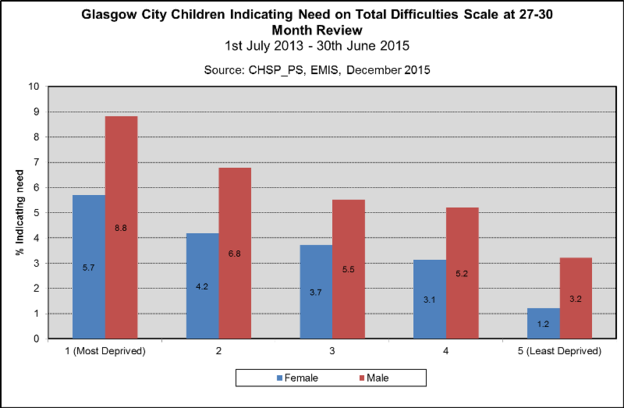Deprivation and gender
Glasgow City Children Indicating Need on SDQ Total Difficulties Scale at 27-30 Month Review 1st July 2013 - 30th June 2015
Click on graph to expand
When area deprivation and gender were analysed together boys were more likely to have difficulties than girls at each level of deprivation. Across both sexes, those in the most deprived areas were more likely than those in the least deprived areas to be in the ‘Indicated need’ group. For example, 7% of boys in the most deprived areas of Glasgow City had difficulties, compared with 2% in the least deprived areas; for girls, the equivalent figures were 6% vs. 1%.
Notes
The SDQ is a brief behavioural screening questionnaire for children. It covers five areas: Conduct Problems, Hyperactivity/inattention, Peer Relationship Problems, Emotional Symptoms and Pro-social Behaviours. The first four of these are rated negatively (that is, they pick up difficulties in children). These can be added together to give a Total Difficulties score, which shows an indication of overall difficulties that the child is experiencing. The final area, Pro-social Behaviours, is a positively scored scale, so it shows things the child does e.g. ‘is helpful if someone is hurt or upset’. The Total Difficulties score and the sub-scale scores can be split into groups which indicate whether a child has no difficulties, possible difficulties or likely difficulties. A global SDQ score of over 17 indicates a behavioural concern. If needs are identified via the SDQ, a set of impact questions is also completed in partnership with the parent or carer to gain a deeper insight into the impact of the current behaviour on the family.
Deprivation – The deprivation quintiles applied are derived from a localised index of deprivation for Glasgow based on Scottish Index of Multiple Deprivation (SIMD, 2012 revision) rankings applied to Glasgow datazones. The purpose of creating this local index of deprivation is to be able to analyse an outcome against an even distribution of deprivation deciles.
SIMD – Scottish Index of Multiple Deprivation provides a relative measure of deprivation based on indicators from 7 domains – income, employment, health, education, access, housing, crime. The index identifies multiple deprivation for 6505 small areas (datazones) across Scotland. There have been four versions of SIMD to date. The initial index of 2004 (SIMD 2004) has been revised three times in 2006 (SIMD 2006), 2009 (SIMD 2009) and 2012 (SIMD 2012). For more information go to the SIMD site.








